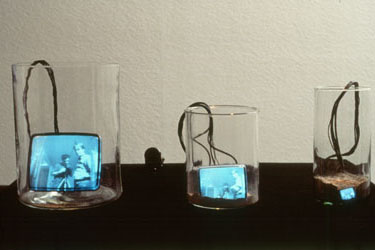Abstract
Tracing his work through the last 15 years, Jim Campbell will address some of the more general issues that have come up with computer mediated art. Starting with Interactivity and ending with what could maybe be called Data Aestheticsization, he suggests how some of the current directions of computer based art making practices are heading towards a formulaic approach.
Campbell’s work has gone through a progression from film to video to interactive installation to electronic sculpture. Thematically the work has been about human memory and its relationship to time and movement from both psychological and scientific perspectives. His earlier interactive works often are structured as psychological mirrors, where the viewer’s response to a work becomes part of the work itself, as in a feedback system. More recent works explore perception at the threshold of recognition of moving images, and postulate what kinds of meaning can be expressed with extremely small amounts of information?
Having spent the last 3 years looking at "the pixel" as one example of an atomic structure of a digital representation, Campbell will discuss how he’s come to the conclusion that the pixel as a visual element doesn't really exist except as a media and art based contrivance to give us something to grasp onto (or to see) as "digital". And finally he'll discuss why these "Art by Number" methods that are being used have evolved naturally out of the structure of the computer.
Bio
Jim Campbell was born in Chicago in 1956 and lives in San Francisco. He received 2 Bachelor of Science Degrees in Mathematics and Engineering from MIT in 1978. His work has been shown internationally and throughout North America in institutions such as the Whitney Museum of Art, San Francisco Museum of Modern Art; the Carpenter Center, Harvard University; The International Center for Photography, New York, and the Intercommunication Center in Tokyo. His electronic art work is included in the collections of the Whitney Museum of American Art, San Francisco Museum of Modern Art; the University Art Museum at Berkeley. In 1992 he created one of the first permanent public interactive video artworks in the U.S. in Phoenix, Arizona. He has lectured on interactive media art at many Institutions, including the Museum of Modern Art in NY. As an engineer he holds more than a dozen patents in the field of video image processing.
-- As of 11/10/03
